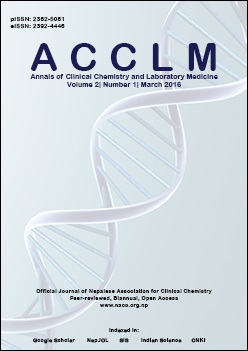Pattern of Thyroid Dysfunction in Women with Menstrual Disorders
DOI:
https://doi.org/10.3126/acclm.v2i1.14195Keywords:
Menstrual disorder, Thyroid dysfunctionAbstract
BACKGROUND
Thyroid disorders are among the commonest endocrine disorders worldwide. Thyroid dysfunction can interfere in multiple metabolic and physiological processes including menstrual cycle. This study was conducted to find pattern of thyroid dysfunction among women with menstrual disorders.
METHODS
Two hundred thirty three females with menstrual disorders were screened for thyroid dysfunction. Thyroid function was assessed by measuring serum free triiodothyronine (T3), free thyroxine (T4) and thyroid stimulating hormone (TSH) levels.
RESULTS
The mean age of study patients was 25.7±6.8 years. The most common menstrual disorder observed was irregular cycle (72.5%, n=169) followed by amenorrhea (21.9%, n=51) and menorrhagia (5.6%, n=13). Most of the patients were in the age group 15-24 years (51.1%, n=119), followed by 25-34 years (36.1%, n=84) and 35-45 years (12.9%, n=30). Mean level of free T3 and T4 was 2.91±1.05 pg/ml, 1.42±0.57 ng/dl respectively. Median TSH was 2.0 mIU/L (IQR, 1.0-4.0). Thyroid dysfunction was seen in 25.8% (n=60) women. Most common thyroid dysfunction was subclinical hypothyroidism (14.2%, n=33) followed by subclinical hyperthyroidism (6.9%, n=16), overt hyperthyroidism (3%, n=7) and overt hypothyroidism (1.7%, n=4).
CONCLUSIONS
The study finds thyroid dysfunction especially subclinical hypothyroidism to be common among women with menstrual disorders. Thus, it may be beneficial to screen menstrual disorder patients for thyroid function especially to rule out thyroid disorder as potential etiological agent for menstrual disturbance.
Downloads
Downloads
Published
How to Cite
Issue
Section
License
Authors who publish with this journal agree to the following terms:
- The author transfers copyright to the Nepalese Association for Clinical Chemistry.
- The journal publishes the work under a Creative Commons Attribution License that allows others to share the work with an acknowledgement of the work's authorship and initial publication in this journal and under the same share-alike license used here.
- Authors are able to enter into separate, additional contractual arrangements for the non-exclusive distribution of the journal's published version of the work (e.g., post it to an institutional repository or publish it in a book), with an acknowledgement of its initial publication in this journal.
- Authors are permitted and encouraged to post their work online (e.g., in institutional repositories or on their website) prior to and during the submission process, as it can lead to productive exchanges, as well as earlier and greater citation of published work (See The Effect of Open Access).




